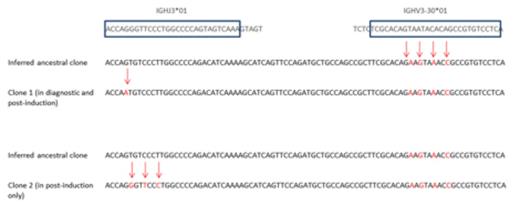Abstract
Introduction: Immunoglobulin (Ig) gene rearrangement is a hallmark of early B-cell development. Multiple myeloma (MM) is a malignancy of plasma cells, which are at the post-germinal center stage of B cell development. Therefore, Ig sequences in MM are typically mutated but are thought to be stable throughout the course of the disease. We previously observed that multiple Ig sequences related by somatic hypermutation (SHM) are present in some MM patients at diagnosis. Here we expanded our previous observations and investigated whether continuous evolution in Ig sequences occurs over the course of treatment.
Methods: 401 MM patientsenrolled in IFM/DFCI study were included in this analysis. The LymphoSIGHT™ platform was used to detect evidence of oligoclonality at the Ig heavy and kappa chain (IGH and IGK) loci. Using universal primer sets, we amplified IGH and IGK variable, diversity, and joining gene segments from RNA isolated from purified CD138+ MM cells collected at the time of diagnosis. Amplified products were sequenced and analyzed (Faham et al., Blood 2012). MM-specific clonotypes were identified for each patient based on their high frequency (5%) within the B-cell repertoire in the diagnostic sample. The highest frequency MM clonotype in a diagnostic sample is termed the "index clonotype." Diagnostic RNA and post-treatment DNA bone marrow samples were assessed for evidence of evolved MM clonotypes. A clonotype was considered "evolved" based on CDR3 sequence homology to the diagnostic "index clonotype."
Results: At diagnosis 10/401 (2.5%) MM patients had 2 unrelated expressed Ig sequences; 4 of these cases (1%) are both functional and therefore are likely to be in 2 different cells. In addition, 71/401 (17.7%) MM patients had evidence of at least 1 evolved clone related through SHM to the index clonotype at diagnosis. 26 of 71 patients had a post-treatment sample tested. Of these 9 are negative for both the index and evolved clone, while 17 are positive for the index clone but not the evolved clone. In 1 of these 17 cases the evolved clone would have been observed if it had the same relative frequency to the index clone as was seen in the diagnostic sample. The observation suggests differential sensitivity to treatment. In a separate analysis, we assessed 120 MRD positive post-induction samples (~6 months after diagnosis) for evidence of evolution. Altogether, 7/120 cases (5.8%) had a pattern of evolution at the post-treatment time point which suggested differential sensitivity to therapy. In 4 patients, the evolved "new" clonotype was not observed at diagnosis but appears in the follow up sample only. In 3 patients, the evolved clonotype either increased or decreased in the post-treatment sample relative to the index clonotype (Fig 1). Interestingly, evolved clones in the follow up sample have 1-4 single base differences compared to the index clone found at diagnosis.
Conclusions: We observed multiple evolved clonotypes in a substantial percentage of diagnostic MM samples (17.8%). The presence of multiple clonotypes related by SHM indicates that this mechanism remains active after myeloma development in at least a portion of the cells. We also found marked changes in the relative frequency of the MM clonotypes in post-induction samples in 5.8% of MRD+ cases, even though the period between diagnosis and post-treatment samples was only 6 months. The emergence of new IgH clones may not be due to selective advantage of the newly acquired mutations in the Ig gene, but rather some other ongoing genomic mutation process. Thus, these evolved myeloma clonotypes may be useful as surrogate markers for other oncogenic mutations providing resistance to therapy.
A)
(A) The top line shows the germline sequence of a section of the V segment. The clonotype in the diagnostic sample has 3 SHMs shown in the section. The clonotype in the follow up sample has acquired an additional SHM. B) Germline V and J sequences are shown on top with the boxed sequences present in the clonotypes and the unboxed bases representing the sequences that were deleted during the VDJ recombination to form the clonotypes. The four arrows denote SHMs that have occurred to generate an inferred but unobserved clonotype. One additional mutation occurs to form the clone seen at diagnosis, while three different mutations appear in the clonotype seen in the follow up sample.
(A) The top line shows the germline sequence of a section of the V segment. The clonotype in the diagnostic sample has 3 SHMs shown in the section. The clonotype in the follow up sample has acquired an additional SHM. B) Germline V and J sequences are shown on top with the boxed sequences present in the clonotypes and the unboxed bases representing the sequences that were deleted during the VDJ recombination to form the clonotypes. The four arrows denote SHMs that have occurred to generate an inferred but unobserved clonotype. One additional mutation occurs to form the clone seen at diagnosis, while three different mutations appear in the clonotype seen in the follow up sample.
B)
Munshi:Celgene: Consultancy; Onyx: Consultancy; Janssen: Consultancy; Sanofi-Aventi: Consultancy; Oncopep: Consultancy, Equity Ownership, Patents & Royalties. Faham:Sequenta, Inc.: Employment, Equity Ownership, Membership on an entity's Board of Directors or advisory committees.
Author notes
Asterisk with author names denotes non-ASH members.



This feature is available to Subscribers Only
Sign In or Create an Account Close Modal